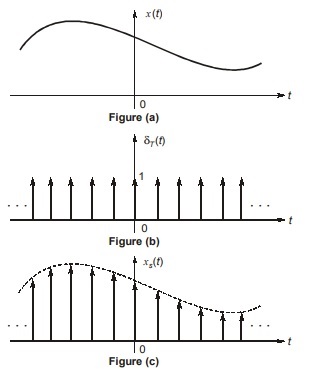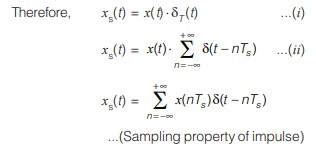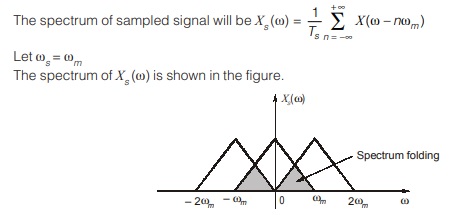Sampling
The process of sampling is a bridge between continuous-time and discrete-time domains. Sampling is a process of converting a continuous-time signal to discrete-time signal and under certain condition the continuous time signal can be completely recovered from its sampled sequence.
The Sampling Theorem 
According to sampling theorem “A band limited signal of finite energy can be completely reconstructed from its samples taken uniformly at a rate ωs ≥ 2ωm samples/rad/sec (or, fs ≥ 2fm sample/sec)”.
In other words, the minimum sampling rate is
fs = 2fm Hz.
To prove sampling theorem, let x(t) be continuous-time finite energy signal whose spectrum is band limited to ωm rad/sec (i.e. X(ω) = 0 for | ω | > ωm).
The input x(t) is sampled at the rate of fs Hz by multiplying x(t) by a periodic impulse train δT (t) with period Ts = 1/fs.
The sampled signal ‘xs(t)’ consists of impulses spaced every Ts second whose strength (area) is equal to instantaneous value of input signal x(t)

Taking Fourier transform of equation (ii) and using multiplication property of Fourier transform

The sampling frequency can take three possible values with respect to spectrum width (2 ωm)
(i) ωs > 2 ωm
(ii) ωs = 2 ωm
(iii) ωs < 2 ωm
Case-1 ω> 2 ωm
Let, ωs = 3 ωm
We see for ωs > 2ωm, there is no overlap between the shifted spectrum of X(ω). Thus, as long as the sampling frequency ωs is greater than the twice the signal bandwidth (2 ωm), x(t) can be recovered by passing the sampled signal xs (t) through ideal or practical low pass filter having bandwidth between ωm and (ωs – ωm) rad/sec.
Case-2 ωs = 2 ωm

We see for ωs = 2 ωm , there is no overlap between shifted spectrum of X(ω). Consequently, x(t) can be recovered from its sampled signal by means of an ideal low pass filter. The minimum sampling rate ωs = 2 ωm (or, fs = 2fm) required to recover x(t) is called Nyquist rate.
Case-3 ωs < 2 ωm
We see for ωs < 2ωm, there is overlap between shifted spectrum of X(ω). Consequently, the signal x(t) cannot be exactly recovered from its sampled signal.
Aliasing or Spectrum Folding
The overlap in shifted spectrum of original signal is termed as “aliasing”.
In other words, “The phenomenon of high frequency component taken on the identity of low frequency component is known as aliasing”. To avoid aliasing, the condition is ωs ≥ 2ωm.

